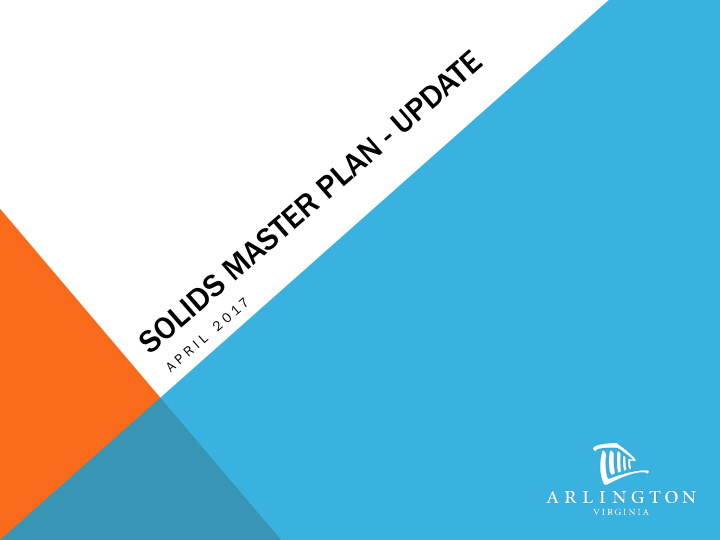



PRESENTATION OVERVIEW • Water Pollution Control Plant Overview • Master Plan History • Current Master Plan • Goals • Process • Timeline • Status of Project
WATER POLLUTION CONTROL PLANT • We treat 25 million gallons of wastewater each day • Our mission is to safely and economically process wastewater and hazardous waste materials to protect our environment • County vision refers to: • secure, attractive residential and commercial neighborhoods • participating, sustainable community
MASTER PLAN HISTORY • Master Plans provide long-term future direction • Last master plan completed in 2001 – plant upgrade to liquid side • Focus of current Master Plan to upgrade the solids handling process in a manner that: • Replaces failing equipment • Provides a sustainable solution that reduces the WPCP’s impact on environment • Takes advantage of innovations in solids handling • Is responsive to community needs (noise, traffic, odor)
WHAT ARE “SOLIDS?” • Residual material recovered from the liquid wastewater treatment processes In Arlington, they result from the Primary and Secondary liquids • treatment processes The WPCP produces approximately 200,000 lbs per day of Class • B biosolids Solids handling processes
WHY EVALUATE CURRENT PROCESS? • Land application may get more expensive • Some solids handling processes 50+ years old – maintenance issues • Solids quantity will continue to increase • More focus County-wide on sustainability and energy management
MASTER PLANNING EFFORT • Obtained input from WPCP staff, DES staff, County Management, and Community Stakeholders • Studied existing infrastructure to determine changes needed • Developed evaluation criteria for new technologies • Determining which technology will be implemented at the WPCP
EVALUATION CRITERIA ▪ Flexibility ▪ Capital Cost ▪ Operabi bility y and Safety ▪ Annual O&M Cost ▪ Constructability ▪ Life e Cycle e Cost st ▪ MOPO/Impacts on Plant ▪ Financial Options/Risk ▪ Proven ▪ End Use Control System/Technology ▪ Reliability Economic Operational Social Environmental ▪ Resource recovery ▪ Odor Gener erati tion on potential Pot oten ential/ / Reduct ction on ▪ Energy Intensity ▪ Acceptability (noise, odor) ▪ Carbon Footprint ▪ Hauling ▪ Regul ulator ory Permit mits ▪ Gas and Product Quality
SOLIDS MASTER PLAN – EVALUATION PROCESS Universe of Technologies Screened Technologies and Process Analysis Top 4 Selected Alternatives Ranking and Final Evaluation We are here Recommended Plan
SOLIDS MASTER PLAN – TIMELINE 2016 2017 2018 2019 19 2020 2020 2021 2022 2022 2023 2023 2024 2025 2025 2026 2026 Immediate Design and construction Needs (Phase I) Short term Design and improvements Study (Phase II) construction Long-term improvements Design and construction (Phase III)
SELECTED LONG-TERM ALTERNATIVES FOR FURTHER EVALUATION Name Bioso solids s Major or featur ures es quality Lime Stabilization rehab- Class B What we have now; most trucks for only biosolids hauling; no gas production odorous Anaerobic Digestion (AD) Class B Biosolids volume lower; gas production; less odors Thermal Hydrolysis (THP) + Class A Biosolids volume reduced further; Anaerobic Digestion more gas production; less odors Anaerobic Digestion + Class A Least amount of biosolids; gas Heat Drying production (used in process — no export); less odors
POTENTIAL BENEFITS TO COUNTY Arlin ingt gton on Operat ations ions Energy gy Plan (2016): ): “The wastewater treatment plant is the single largest energy user in County operations, consuming 13% of all energy use” Arlin ingt gton on Commun unit ity Energy gy Plan Analy lysis is (2016): ): “In 2007, total emissions from the WPCP were nearly 21% of the total government operations’ net emissions” Commun unit ity Energy gy Plan Analy lysis is for the e Solids ids Master er Plan n (2016): ): “Offsetting either natural gas or electricity, AD and THP/AD will provide extremely significant reductions to the plant’s carbon footprint.”
ANAEROBIC DIGESTION
HEAT DRYING
THERMAL HYDROLYSIS PROCESS
OPERATIONAL PROJECTIONS Lime e Anaer erobi obic c THP + + Anaer erobi obic c Diges estion on Anaer erobi obic c Diges estion on + + Digest estion on Heat t Drying ng Solids 259,000 155,000 115,000 43,000 production in lbs/day lbs/day lbs/day lbs/day 2021 Net gas N/A 192 million 228 million N/A (no export) production in BTU BTU 2021 Greenhouse N/A -8% (natural -9/-39% +14%/-11% gas impact for gas)/-33% WPCP in 2020 (electricity) Number of 40 26 19 12 trucks per week in 2021
THANK YOU! https://water.arlingtonva.us/locations/water-pollution-control-plant/ https://projects.arlingtonva.us/projects/water-pollution-control-plant- solids-master-plan/ Mary Strawn mstrawn@arlingtonva.us
Recommend
More recommend